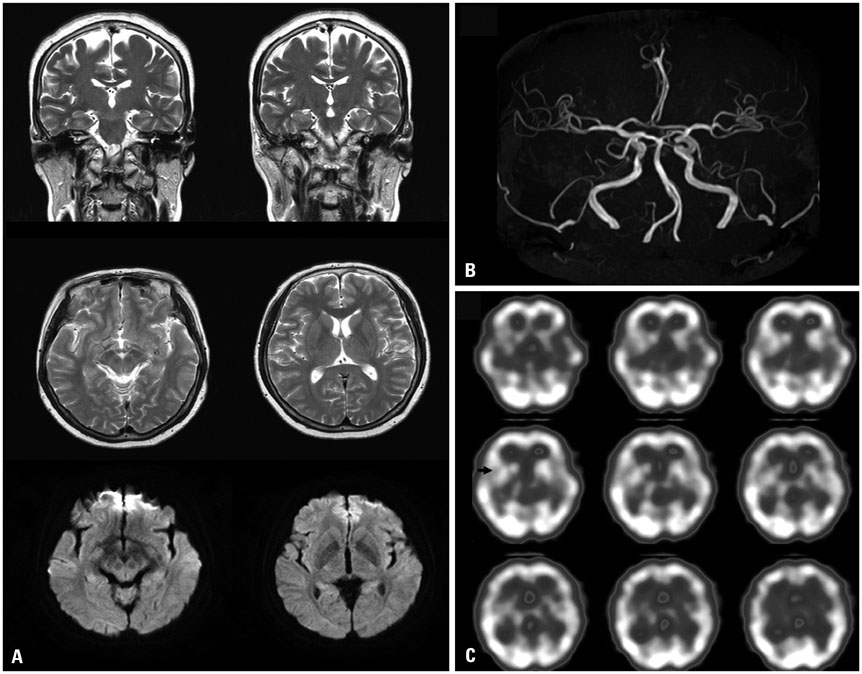Yonsei Med J.
2016 May;57(3):803-805. 10.3349/ymj.2016.57.3.803.
Levosulpiride-Associated Hemichorea
- Affiliations
-
- 1Department of Neurology, Dongtan Sacred Heart Hospital, Hallym University College of Medicine, Hwaseong, Korea. sukyunkang@hanmail.net
- 2Department of Neurology, Kangnam Sacred Heart Hospital, Hallym University College of Medicine, Seoul, Korea.
- KMID: 2374106
- DOI: http://doi.org/10.3349/ymj.2016.57.3.803
Abstract
- No abstract available.
Figure
Reference
-
1. Postuma RB, Lang AE. Hemiballism: revisiting a classic disorder. Lancet Neurol. 2003; 2:661–668.
Article2. Baba M, Terada A, Hishida R, Matsunaga M, Kawabe Y, Takebe K. Persistent hemichorea associated with thyrotoxicosis. Intern Med. 1992; 31:1144–1146.
Article3. Dragasević N, Petković-Medved B, Svetel M, Filipović SR, Kostić VS. Paroxysmal hemiballism and idiopathic hypoparathyroidism. J Neurol. 1997; 244:389–390.
Article4. Lai MH, Wang TY, Chang CC, Tsai KC, Chang ST. Hemichorea associated with gabapentin therapy with hypoperfusion in contralateral basal ganglion - a case of a paraplegic patient with neuropathic pain. J Clin Pharm Ther. 2008; 33:83–86.
Article5. Sheen VL, Asimakopoulos F, Heyman E, Henderson G, Feske SK. Hemichorea as a presentation of recurrent non-Hodgkin's lymphoma. J Neurol. 2002; 249:1746–1748.
Article6. Shin HW, Kim MJ, Kim JS, Lee MC, Chung SJ. Levosulpiride-induced movement disorders. Mov Disord. 2009; 24:2249–2253.
Article7. Oh SH, Lee KY, Im JH, Lee MS. Chorea associated with non-ketotic hyperglycemia and hyperintensity basal ganglia lesion on T1-weighted brain MRI study: a meta-analysis of 53 cases including four present cases. J Neurol Sci. 2002; 200:57–62.
Article8. Müller-Vahl KR, Berding G, Emrich HM, Peschel T. Chorea-acanthocytosis in monozygotic twins: clinical findings and neuropathological changes as detected by diffusion tensor imaging, FDG-PET and (123)I-beta-CIT-SPECT. J Neurol. 2007; 254:1081–1088.
Article9. Ginovart N, Lundin A, Farde L, Halldin C, Bäckman L, Swahn CG, et al. PET study of the pre- and post-synaptic dopaminergic markers for the neurodegenerative process in Huntington's disease. Brain. 1997; 120(Pt 3):503–514.
Article10. Lehmann AB. Reversible chorea due to ranitidine and cimetidine. Lancet. 1988; 2:158.
Article
- Full Text Links
- Actions
-
Cited
- CITED
-
- Close
- Share
- Similar articles
-
- A Case of Ipsilateral Hemichorea Due to Thalamic Infarction
- Delayed Hemichorea Syndrome Associated with Nonketotic Hyperglycemia
- A Case of Hemichorea with Primary Somatosensory Cortical Infarction
- Hemichorea following Temporo-Parietal Infarction
- The Effects of Pyridostigmine and Levosulpiride on the Contraction of Rabbit Urinary Bladders


